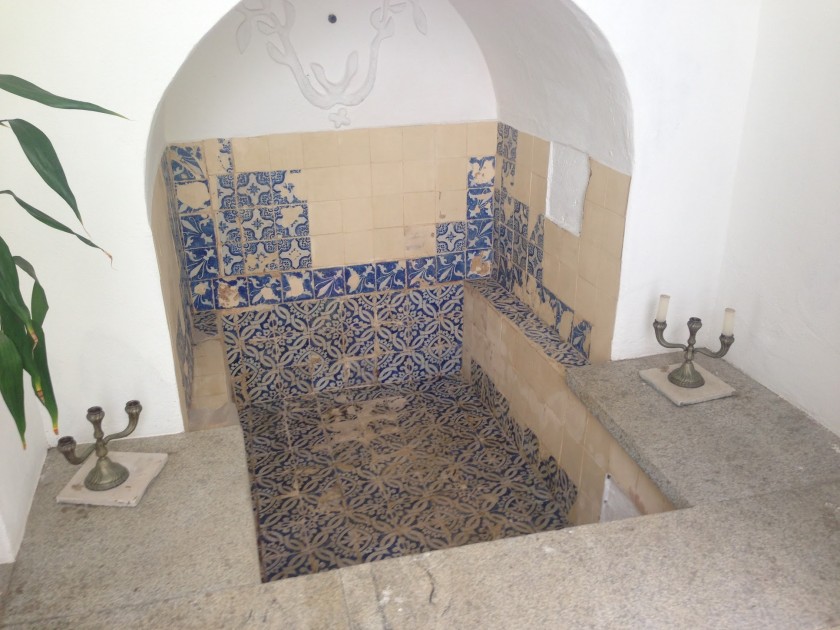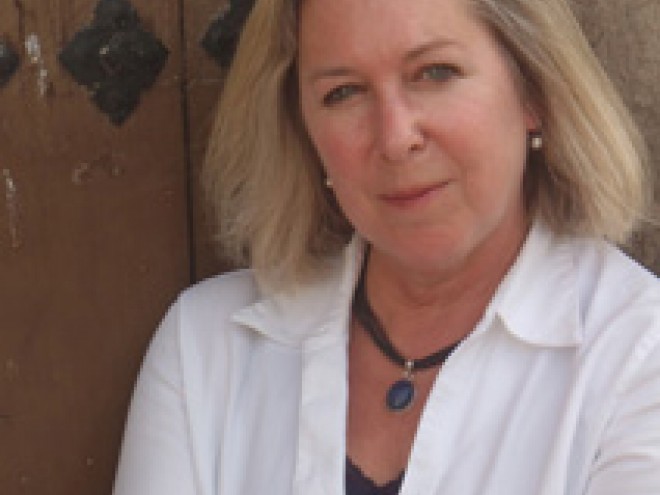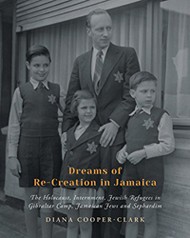
Mikvah, photo by Daniela Weil
In July of 2016, I schlepped my family to Brazil. We left our comfy, suburban, Houston life and headed for a semester abroad in the tropics. My husband was able to convince his boss that working remotely would not be an issue, which in a pre-COVID world was no easy feat.
I am Brazilian. I wanted my family to have a cultural experience. But I didn’t want to go back “home” to São Paulo, a huge, modern city. I wanted to delve into the soul of Brazil, its history, its rich African culture. And I wanted my daughter — who is adopted from Africa — to experience that too. I wanted her to live in a place whose population was predominantly black. So we moved to Salvador, Bahia.
Salvador was Brazil’s first capital, between 1549 and 1763, and the major economic center of South America during the “glory days” of the triangular trade. It’s port was the most likely place where a chained, kidnapped African would have set foot in the New World if he or she had survived the grueling three month Atlantic crossing. Today, more than 80 percent of Bahia’s inhabitants are of African descent.
Bahia was fertile territory for the expansion of the Catholic church and its favorite pastime: the Inquisition. But despite forced conversions, the slaves secretly practiced their African faith in late night Candomblé ceremonies. While pretending to be Catholics, they blended both faiths by assigning their Orixa gods to the Catholic saint images in order to avert the Inquisition and punishment; Candomblé has survived in Bahia until modern times.
But after being there a few months, I started to wonder: where were the Jews? Brazil and Argentina have some of the largest number of Jews in South America. In Salvador, a city of three million inhabitants, there were only about two-hundred Jews. Ignorance about Judaism abounded. Many of the white parents at my daughter’s private school had never met a Jew. “What do you mean you don’t believe in Santa Claus?” they would ask. “Do Jews believe in God?” Being in a place with zero Jewish history was perplexing to me. What happened here? Jews had been doing such a successful job at hiding in Bahia for so many centuries, that it was no wonder people didn’t know they existed.
While in Brazil, I was researching a story for a children’s book I was writing. It was about the very first synagogue in the New World, built in 1632 in the town of Recife — just over a ten hour drive north of Salvador. Recife was home to a short lived Dutch colony, one of the only places in the world where Jews could worship openly and freely in the 1600s. During my research, I came across an article in a Brazilian magazine about a recently discovered seventeenth-century alleged mikvah in a hotel at the historic center of Salvador; I had never heard of a mikvah in Salvador. Unlike the “colonial Jerusalem” occurring in Recife, Bahia was the center of the Portuguese Inquisition. I salivated at the thought of going after that story, and. so I added visiting the Hotel Villa Bahia to my to-do list.
But after being there a few months, I started to wonder: where were the Jews? Brazil and Argentina have some of the largest number of Jews in South America.
My family and I strolled around the historic center of Salvador, the Pelourinho (the literal translation means the old slave whipping post), almost every weekend. If you’ve seen Michael Jackson’s video “They Don’t Care About Us”, you might recognize it. Brightly colored two-story colonial town-homes lined the maze of cobblestone streets. African drum rhythms faded in and out as we walked up and down the hills. The towering church steeples loomed at almost every corner, as if keeping a watchful eye on each resident’s movements. A massive stone cross hovered over the town square, a constant reminder of who was in charge.
The next few months’ work can be summarized by many failed attempts to visit the supposed mikvah. Between repressive hotel staff and multiple unreturned phone calls, I felt like a goy attempting to convert to Judaism in an orthodox synagogue. Was this a test to measure how much I really wanted to see this so-called mikvah? It wasn’t until a week before we left Bahia, that I scored a meeting with Mr. Bruno Guinard, the French hotel owner. At the rustic hotel lobby, Brunol appeared, speaking Portuguese with a heavy French accent. “How much time do you have?” He asked. And then, the story began to unroll.
“A few years ago,” he began, “a Jewish guest from Europe noticed the odd looking fountain near the courtyard. She told me she thought it might be a mikvah.”
What was a mikvah? he wondered. He shrugged it away, until a second Jewish visitor asked the same question.
He decided to go to the office of historical heritage to inquire about the guests’ assertion. They sent a team to inspect the hotel, and gave him a verdict: The fountain was nothing more than a Portuguese Bath. Now, Bruno knew little if nothing of Jewish history. He had heard of Turkish Baths, and Japanese Baths, but he knew he had never heard of a Portuguese Bath before. And he knew baths only began being built in the homes in Salvador in the nineteenth century. That made him think something was indeed fishy. His curiosity led him to jump down the research rabbit hole himself.
Bruno began to research Crypto Jews during the Inquisition. He learned of all the different ways that they laid low: torahs hidden behind false walls, secret compartments in homes, subtle markings on stone. Despite little academic research about the Jews in Bahia, many historians believe that up to three-fifths of the population may have been New Christians, Jews who converted during the Inquisition. Bruno found out that about 80 percent of the Inquisitorial cases in Bahia were for secret Jewish practices.
Bruno had been unsuccessfully trying to find the original owner of his house for years. But through a stroke of serendipity, he bumped into the right connection at an ice cream shop, and was granted access to the archives in the Franciscan Church next door. He dug through the crumbling pages of seventeenth-century books until he found this name within a legal document: Francisco de Oliveira Porto. Jackpot! The mystery man was ousted — here was the original owner of the house.
Bruno had been unsuccessfully trying to find the original owner of his house for years. But through a stroke of serendipity, he bumped into the right connection at an ice cream shop.

Hotel Villa Bahia (yellow house on the right) where the mikvah is housed, across the street from the inquisitor’s house (blue house on the left), photo by Daniela Weil
With the help of a scholar, Dr. Suzana Severs, Bruno began a process of restoring the mikvah, which revealed seventeenth century Portuguese tiles. The two-hundred-seventy gallon tub was filled by a fresh rain-water reservoir above it. Bruno dove into the study of mikvahs. Though traditional dimensions were very specific, the crucial need was to completely submerge a person. Gravity or natural pressure gradient must supply it with fresh water. Bruno used his body for a submersion test; it passed.
Then, in 2012, during an Inquisition conference in Salvador, Bruno asked Dr. Severs if they should go public with the mikvah. Dr. Severs suggested inviting her friend, Dr. Anita Novinsky, the highest authority on the history of the Jews in Brazil, for lunch at the hotel. They agreed to not say a thing.
Dr. Novinsky came the next day. After lunch, they strolled the hotel grounds. She paused in front of the fountain. Bruno replayed the conversation:
“I can’t believe what I see,” Dr. Novinsky said.
“What do you see, Anita?” asked Bruno.
“Is this a… mikvah?” she muttered.
“Your words…” Bruno did not want to lead her on.
She began to cry.
“You don’t know what this means. I have been researching Jews in Bahia for forty years. No one has been interested in my work. No one has ever found a thing. You don’t understand the importance of this. It is an artifact of the secret underground!”
In the years that followed, Bruno continued to keep the five-hundred year old mikvah a secret. He wanted to be sure of what it was before being crucified for proclaiming falsities. So Bruno called a series of rabbis to inspect the structure and give him a verdict. And, as typical Jews, they could not agree. The truth is that it was impossible to attain certainty. After all, crypto-mikvahs were never meant to be outed.
When the Chabad Center rabbi came, he measured it like a tailor suiting a king. After hours of work, Bruno asked him: “So Rabbi, is this a mikvah or isn’t it?”
Bruno, hoping the question would finally be laid to rest, was not expecting the rabbi’s typical rabbinical answer. “It doesn’t really matter whether it was a mikvah or not.”
“What do you mean?”
“What matters is the history that you unfolded.”
____
As we walked out to leave, Bruno pointed to a house across the street. “See that blue house?”
“Yes,” I answered, “what about it?”
“That was the home of the chief Inquisitor.”
“What? Why would a secret Jew build a mikvah in his house when he lives right across the street from the Inquisitor?” I asked, incredulously.
“If you were the Inquisitor, would you think anyone would have the nerve to be using a mikvah just feet away from your house?”
That made a tremendous amount of unexpected sense — hiding in plain sight.
“I’m not Jewish and I don’t have Jewish culture,” said Bruno, “but what fascinates me the most is the resistance. I think it’s incredible! Putting a mikvah in the middle of the Catholic orders during the Inquisition. It’s either a lot of stubbornness, or a lot of faith. Right down the street are the order of the Dominicans, which represented the Inquisition. Down the street, the Jesuits, and right here, the Franciscans. Across the street, the agent of the Inquisition. Let’s put a mikvah right under everyone’s noses!”
We returned to Houston in January of 2017. I think about Mr. Porto’s mikvah almost every day.
Daniela Weil grew up in Brazil. She always had a passion for art and nature, and studied biology at Brandeis University. After working with whales, Daniela moved to Houston to make 3D animations for science. Daniela became a full-time children’s writer and illustrator after adopting her daughter Lucy. She loves to inspire children through her writing. She lives in Austin, TX. Her book, The Diary of Asser Levy, is out now.



